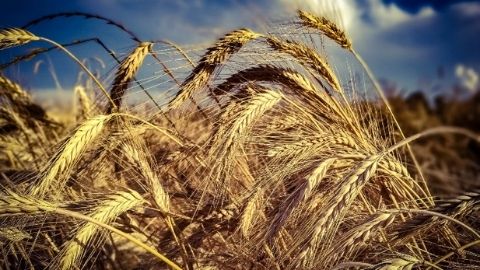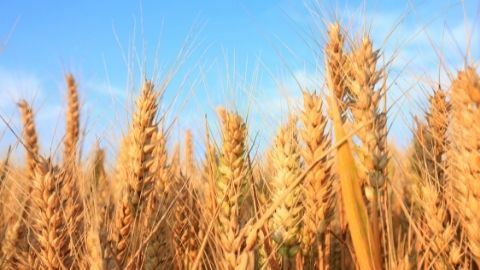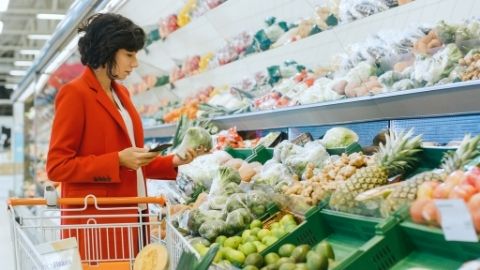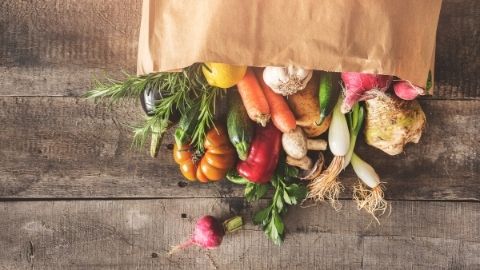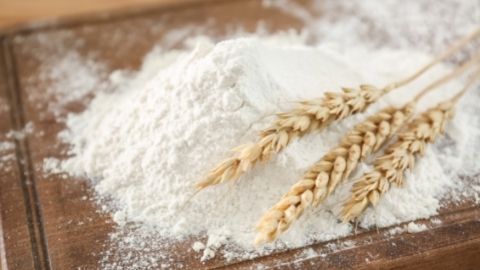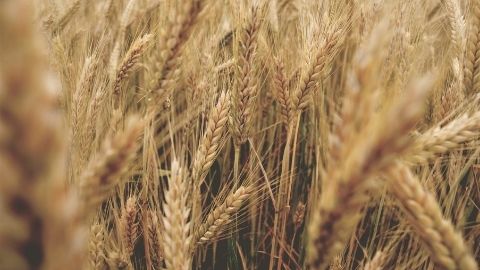Premium Potential for Organic Wheat Products
Introduction
The demand for organic wheat products, such as breads and snack foods, in the U.S. is currently higher than the availability of organic wheat. Sales of organic foods in 2017 were 13 times the level of sales in 1997 ($3.4 billion to $45.2 billion) (Organic Trade Association, 2018). Additionally, organic wheat acreage was 6.7% of all organic acreage in 2016, but the share of bread and grains in organic food consumption was already 9% in 2012 (USDA-NASS, 2017). For producers, using organic methods often comes with additional costs, knowledge investment, and forgoing organic premiums to offset additional production costs during the 3-year conversion period. A study conducted in 2009 found that the cost of producing a bushel of organic wheat ranged from $2 to $4 more than conventional wheat production ($55 to $62 more per acre higher), and the average premium for organic wheat per bushel was $3.79 (McBride et al., 2012). Hence, the higher costs of organic wheat production are likely offset by the premium gained, although organic wheat prices have fluctuated more than conventional wheat prices historically (McKay, 2016).
This Extension fact sheet provides an overview of the premiums consumers in the Western U.S. are willing to pay for organic wheat products, as well as their knowledge of organic production methods, and opinions and attitudes toward organic food products in general.
Data Overview
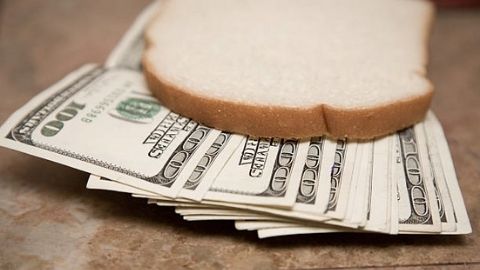 Consumer data was collected through an online Qualtrics survey conducted with U.S. residents across 16 U.S. Western states in June 2017. Over one thousand consumers from across the West responded to the survey. Respondents were asked questions about their shopping and organic consumption habits, lifestyle, preferences for wheat products, reasons for purchasing or not purchasing organic products, general attitudes towards organic foods, knowledge of organic production, and general socio-demographic questions.
Consumer data was collected through an online Qualtrics survey conducted with U.S. residents across 16 U.S. Western states in June 2017. Over one thousand consumers from across the West responded to the survey. Respondents were asked questions about their shopping and organic consumption habits, lifestyle, preferences for wheat products, reasons for purchasing or not purchasing organic products, general attitudes towards organic foods, knowledge of organic production, and general socio-demographic questions.
The sample is fairly representative of the population in the Western U.S. as shown in Table 1. The portion of those with some college, a college degree, or gradaute degree is greater in the sample than in the general population. Also, those with household incomes higher than $100,000 is lower in the sample than in the general population. Female respondents make up 51% of the sample and 50% of respondents are married. Thirty-three percent of households have children, with an average household size of a 2.7 persons. There are a wide range of ethnicities represented with the largest proportion white (72%), a higher proportion than the general population. The majority of respondents completed at least some college (43%), while respondents with 4-year college degrees or graduate degrees totaled 39%. The number employed was slightly lower (approx. 7% lower) than the population average, but the employment rate was basically the same.
Table 1. Sample Socio-Demographics (%)
| Characteristic | Sample Mean | U.S. West* | |
|---|---|---|---|
| Female | 51.6 | 50.6 | |
| Age Group | 18-24 yrs. | 11.8 | 13.0 |
| 25-44 yrs. | 35.2 | 35.8 | |
| 45-64 yrs. | 35.5 | 32.8 | |
| >65 yrs. | 17.5 | 18.4 | |
| Annual household income | <$10,000 | 5.9 | 6.1 |
| $10,000-$49,999 | 44.7 | 36.6 | |
| $50,000-$99,999 | 32.9 | 30.3 | |
| $100,000-$149,999 | 10.7 | 14.4 | |
| >$150,000 | 5.7 | 12.6 | |
| Married | 50.1 | 52.2 | |
| Household size (# persons) | 2.7 | 2.8 | |
| Presence of children <18 years | 33.6 | 32.9 | |
| Education attainment | Less than high school | 0.5 | 14.0 |
| High school | 16.7 | 24.2 | |
| Some college | 43.1 | 33.3 | |
| 4-year college | 26.6 | 18.5 | |
| Graduate degree or higher | 13.2 | 10.0 | |
| Labor force participation rate | 56.2 | 63.3 | |
| Unemployment rate | 6.8 | 6.5 | |
| Ethnic background | African American | 5.4 | 4.8 |
| American Indian | 1.0 | 1.7 | |
| Asian | 6.3 | 8.8 | |
| Hawaiian | 0.2 | 0.3 | |
| White (non-Hispanic) | 72.2 | 58.6 | |
| White (Hispanic) | 9.2 | 15.1 | |
*Census data for U.S. West, 2010 (See https://www.census.gov).
Willingness to Pay
For the entire survey sample the willingness to pay was $1.37 for one loaf of organic bread and $2.05 for a box of organic cookies (See Table 2).
Table 2: Willingess-to-Pay for Organic Foods ($)
| Entire Sample | Very likely | Likely | Unlikely | |
|---|---|---|---|---|
| Bread ($/loaf) | $1.37 | $3.57 | $1.91 | -$0.52 |
| Cookies ($/box) | $2.05 | $34.89 | $0.88 | -$0.46 |
Respondents were then grouped by their past organic wheat product consumption levels. Three groups emerged. The “very likely” group was willing to pay the most for organic bread ($3.57). For organic cookies, they were willing to pay $34.89 a box. On average, the “likely” group was willing to pay less for organic bread ($1.91) and significantly less for cookies ($0.88) than the “very likely” group. The “unlikely” group was the least likely to purchase organic bread. This group actually would not buy organic bread or cookies unless they were offered a discount.
Organic Food Opinions
Respondents were asked a series of questions based about their opinions regarding organic foods on a scale of 1-5, were 1 is disagree and 5 is strongly agree. For the overall sample, the respondents ranked the statements that “organic products are too expensive” and “organic production is better for the environment” higher. However, a larger percentage agreed/strongly agreed that “organic products are healthier” slightly more than the percentages that agreed that “organic production is better for the environment.” The sample ranked the statements “organic products are not safer” and “organics don’t support local growers” the lowest. Close to half of the respondents agreed/strongly agreed that the selection of organic products in the grocery store isn’t good. Hence, there seems to be an opportunity to expand organic wheat product selection or at least offered higher quantities of current products at more grocery outlets.
Table 3: Opinions Regarding Organic Foods (Scale of 1-5)
| Statement | Sample Average Ranking | Agree/ Strongly Agree (%) |
|---|---|---|
| Organic products are healthier than conventional products | 3.64 | 61.4% |
| Organic products are fresher than conventional products | 3.22 | 37.96% |
| Organic products are not safer than conventional products | 2.85 | 28.84% |
| Organic products do not taste better than conventional products | 3.14 | 41.33% |
| Organic products are too expensive | 3.96 | 77.80% |
| The selection of organic products in stores isn't good | 3.20 | 44.50% |
| Organic products do not contain harmful substances | 3.49 | 51.64% |
| Organic production is better for the environment | 3.66 | 56.59% |
| Buying organic food does not benefit local farmers | 2.69 | 17.34% |

Knowledge of Organic Production Methods
Survey respondents were given a test, including six questions, to measure their knowledge of organic production methods. Respondents were also asked to report their level of familiarity with organic production methods (not familiar, unsure, or familiar, where not familiar is 0 and familiar is 2). As shown in Table 4, the full sample didn’t do so well on the test and achieved a test score of 34%. The “very likely” group (to consumer organic bread or cookies) only achieved a score of 40% and the “unlikely” group around 30%. The “very likely” group did report their familiarity rather high at 1.4 of a total possible of 2. The likely group’s self-reported knowledge was close to the full sample average at .7 (unsure or unfamiliar). These results show that the majority of the survey respondents, don’t fully understand organic production methods even those who consume organic foods on a regular basis.
Conclusions
Consumers who are “very likely” to purchase organic foods were willing to pay almost twice as much as the consumers who are simply “likely” to purchase organics and just over $4.00 more than those “unlikely” to purchase organic foods. The majority of the respondents do believe that organic foods are healthier and better for the environment, but generally find them to be too expensive. Those that do wish to purchase organic breads and cookies, feel that the availability of such products is too low. Hence, there is an opportunity to expand organic wheat product selection and increase sales if organic wheat is available for expanded and new product development. Also, the lack of understanding among consumers with regards to organic production standards, illustrates the need for education surrounding organic production methods and the advantages and disadvantages of such.
Table 4: Sample Results on Tested and Self-Reported Organic Production Knowledge
| Tested Knowledge (Out of 100%) | Self-Reported Familiarity | |||||||
|---|---|---|---|---|---|---|---|---|
| Full Sample | Very likely | Likely | Unlikely | Full Sample | Very Likely | Likely | Unlikely | |
| Bread | 34.54% | 40.23% | 35.71% | 29.81% | 0.797 | 1.235 | 0.749 | 0.517 |
| Cookies | 34.54% | 43.82% | 36.74% | 32.87% | 0.797 | 1.452 | 1.069 | 0.635 |
References
- McBride, W.D., C.R. Greene, M.B. Ali, and L. Foreman. 2012. The Structure and Profitability of Organic Field Crop Production: The Case of Wheat.” Presented at AAEA annual meeting, Seattle WA, 12-14 August.
- McKay, S.M. 2016. Understanding Organic Prices: An Analysis of Organic Price Risk and Premiums. MS thesis, Virginia Tech.
- Organic Trade Association. 2017. Robust Organic Sector Stays on Upward Climb, Posts New Records in U.S. Sales. Online at: https://www.ota.com/news/press-releases/19681.
- U.S. Department of Agriculture, National Agricultural Statistics Service (USDA-NASS). 2017. Certified Organic Survey 2016 Summary. Washington DC, September. Online at: https://www.nass.usda.gov/Publications/Todays_Reports/reports/census17.pdf.
Date Published: December 2018
Authors
Kynda R. Curtis, Professor and Extension Specialist, Department of Applied Economics; Tatiana Drugova, Graduate Research Assistant, Department of Applied Economics; Haylea Thomason, Small Farm Extension Marketing Intern, Department of Applied Economics
Related Research




